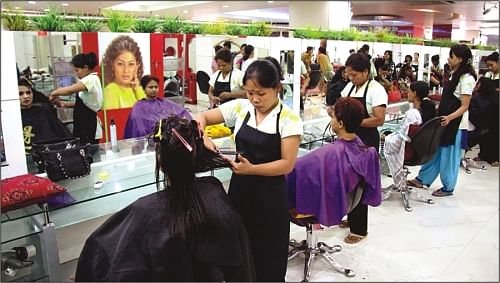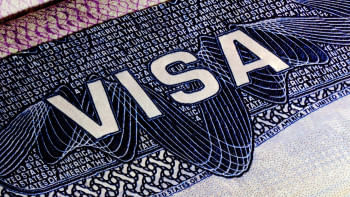Beauties at the city’s beauty shops

INSIDE A BEAUTY SALON: Around 5, 000 Mandi girls work in the city's parlours.Photo: STAR
Tripola Shangma, a 20-year-old Mandi (Garo) woman, ran away from home when she was fourteen, to fulfil her dream -- to work in a beauty salon.
Hailed from Jalchhatra village in Madhupur forest, Tripola soon found employment at a beauty parlour in Mirpur, one of around 400 such parlours in the city.
She became a skilled beauty worker within a year and now works at Farzana Shakil's, a top beauty salon in the city. For her, it was a dream-come-true mission.
Now she knows threading, haircut, facial, bridal make-up and all the other secrets of the beauty profession.
Tripala is one of around 5,000 Mandi girls working at beauty salons in Dhaka city. These Garo girls are the main workforce of the beauty business.
With a few exceptions, there are hardly any Bangalee service providers in the beauty salons. The Mandi women simply dominate the parlours. Girls from other indigenous communities are yet to take up this profession.
According to Mandi community leaders there are several hundred salons across the country, majority of which are in Chittagong and Sylhet. However, there is no official statistics about the total number of such salons.
To the Mandi girls, who enjoy equal status with men in their matrilineal society, working in a beauty salon is the highest achievement in life.
“When I was 14 all my friends came to work for beauty parlours in Dhaka. I took it as my destiny too. The beginning was excruciating. I only stood beside the seniors and watched for around 10 hours a day. But in the end it was useful,” said Tripola.
Most workers mentioned that they were encouraged to join the profession by their relatives or acquaintances. In the beginning most of these women start as unpaid trainees in their early teen. Majority of them start with smaller salons in the suburbs.
A large number of young women join during Eid season when every beauty parlour needs additional workers. Migration from Mandi villages, however, continues round the year.
The trainees stand beside seniors to learn the art of makeover. It takes about a year to learn it all and even more time to develop a perfectly adept hand. Trainee workers only receive accommodation, food and occasionally a Tk 500 pocket money.
With experience they start moving towards salons of the high-end range. The most experienced beauty worker can get a salary up to Tk 15,000 per month.
The two largest beauty parlours in Dhaka are Persona and Farzana Shakil's that employ around 1000 Mandi girls in their five branches.
Most of the women working in parlours live in mess houses, arranged by the owners. Strong community feeling is one of the most important features of these workers.
Kavita Snal from Amlitala, Madhupur said, “I can share joy and sorrow with the people from my community, often from my own village. I also feel secure amidst my people.”
Although the Mandi women provide the service they never set the trend and has very little chances of becoming their own masters. In Dhaka there is only one parlour named Shahi's in Mohammadpur that is owned by a Mandi woman.
Nipa Shangma from Chapait, Madhupur, working at Persona said, “Working at a parlour is a young Mandi woman's ultimate dream but there is no place to go from here as we don't have enough money to set up our own salons. So when they become older Mandi women always dream of buying land in the village.”
These Mandi workers hail from Madhupur forest, Haluaghat, Jhinaigati, Durgapur, Kalmakanda, Nalitabari and Muktagachha in Mymensingh, Tangail, Sherpur and Netrakona districts. More than 100,000 Mandis live in this area.
According to an estimation of Bangladesh Indigenous Peoples Forum, more than 50 percent of the Mandi beauty workers hail from Madhupur forest.
Nandi Marak, one of the first generation workers to arrive in Dhaka, explains why.
“Land was our main source of livelihood. Our forefathers used land for farming and did not know about property rights. They did not know about paper works and that's how we lost it all to the Bangalees,” narrates Nandi who started working with May Fair at the age of 12 in 1979.
Majority of workers said poverty was the main reason for their migration to the city. Most of these young women are the sole breadwinner of their family. They all start at their early teen, which also indicates a high dropout rate from the school.
Sanjeeb Drong, general secretary, Bangladesh Indigenous Peoples Forum, said, Mandi community was very much attached to forest and nature but life became complicated for them for many reasons.
“Poverty and displacement caused by landlessness, establishment of eco-park, forest destruction, biodiversity changes are forcing more and more people from the Madhupur Mandi community to migrate to Dhaka,” he said.
Migration of Mandi women in large numbers started in the early 80s. They became mostly garment workers. But soon they were replaced by Bangalee workers. Many chose the profession of nursing or domestic help at the house of the foreign diplomats.
But at the same time they were increasingly hired by the beauty parlours, said Drong who also belongs to the Mandi community.
Drong mentions that Mandi women have been a bit more successful than Mandi men in finding work. They face lesser barriers in their society, enjoy freedom of mobility, and tend to lead as it is a matrilineal society.
These young indigenous women however are allegedly subjected to many discriminations by a section of salon owners. Except for a few renowned salons, the situation is appalling in most of the parlours, Drong alleged.
Working hours are very long. Often they are made to work without weekly holiday. Situation worsens during festival season. Many owners force the workers to reside inside the parlours to save house rent money. Trainee workers are often forced to do household work at the owner's house. Salaries are not paid regularly.
“For lack of legal support for indigenous people these young women tend to stay quiet about their problems in most cases,” Drong said.
Carmel Hsieh and her May Fair tale
The trail of the first Mandi woman joining beauty parlour goes a long way back to 1965 when Carmel Hsieh, a Bangladeshi born Chinese woman established the first beauty parlour in Dhaka named May Fair.
Living in Hong Kong at present Hsieh pays occasional visits to her daughter Monica Hsieh, the current owner of the parlour.
Hsieh recalls the first Mandi woman's joining her crew of five Chinese beauty workers in 1968.
“Back then only the Chinese women used to run the business that saw a few customers mostly belonging to the expatriate community and a few film stars,” she said.
At that time Hsieh also owned a Chinese restaurant named Shanghai. The Bangalee Muslim cook of the restaurant Shukhu married a Mandi woman named Sharothi. Soon after the marriage Sharothi was employed by Hsieh at her salon.
Gradually the middleclass womenfolk found their new passion for beauty. The salon gained popularity and eventually needed more workforce. The very few Chinese women living in Dhaka could not provide sufficient service to the growing pressure. Some of them left May Fair wanting to open their own parlour.
Hsieh noted that she had requested more Mandi workers who according to her point of view, learnt the trait easily and were hardworking. “Sharothi's relatives joined her at first. Then the news spread, and more people came in. That's how it all started,” said Hsieh.
“Chinese women were the known beauty experts from the beginning. Bangalee customers wanted to see Chinese faces and Mandi women having the mongoloid features perfectly served the purpose. Sharothis's arrival however was not planned,” Hsieh added.
The migration began slowly but soon the news reached other Mandi villages inspiring more to migrate for an alternative urban livelihood.
This transition period stayed till early 1980s. Today Mandi women constitute more than 95 percent of the service providers in beauty salons.

 For all latest news, follow The Daily Star's Google News channel.
For all latest news, follow The Daily Star's Google News channel. 



Comments